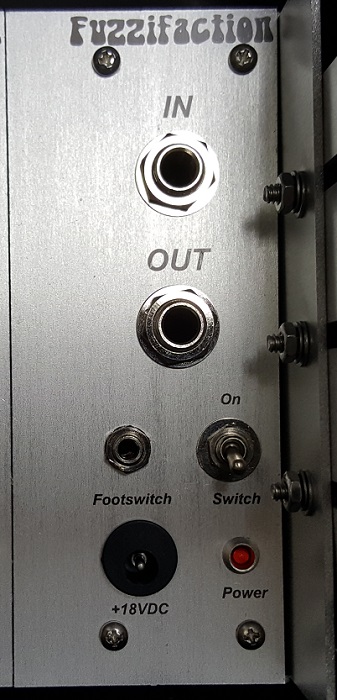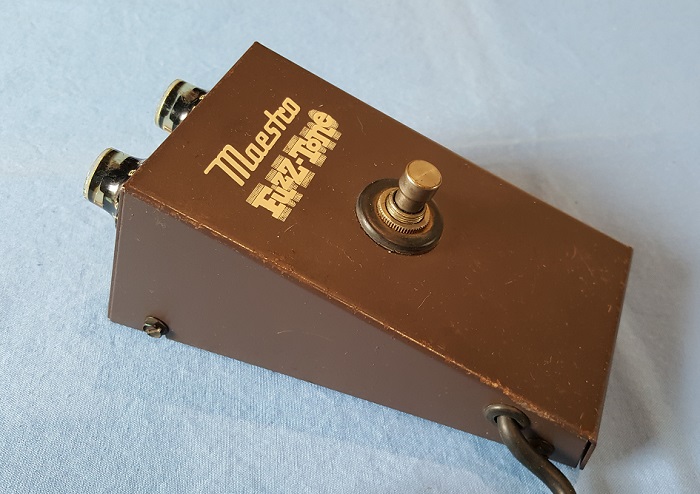Fuzzifaction
Rude, raw, aggressive, in-your-face fuzz. Get some fuzz satisfaction.
 |
 |
 |
 |
The Fuzzifaction fuzz rack effect module compares to the Maestro FZ-1 and FZ-1A fuzz pedals of the 60's. Turn it up and get the original, rudest, rawest, in-your-face, stick-it-to-the-man fuzz tone available. Invented just in time to make it unnecessary for Keith to use a saxophone for That Riff, as he reportedly intended. Probably the most attitude-filled effect of all time.
Description
Keith used the Maestro FZ-1 fuzz to create one of the most famous and raucous opening riffs in rock history - just two bars of musical genius that captured an era and an attitude. As soon as you hear the first two notes, you know what's coming. Turn it up, all the way!
The FZ-1 was one of the first pedals of any type available, and was quickly followed by many copies and derivatives. Maestro replaced it with FZ-1A and other models to meet the fast-growing demand for fuzz pedals. The Tonebender was the other fuzz pedal of the day, and the circuits are very similar. We build our Fuzzifaction modules using our Fuzzbender boards. The Fuzzbender variants tend to be smoother and somewhat more refined than the FZ-1's raw and cutting fuzz. Like most good fuzzes, you can dial in different tones, but the FZ-1 and FZ-1A seem to be meant for cranked up, take-no-prisoners, all-out rock and roll mayhem.
There are very few differences between the FZ-1 and FZ-1A that matter. The FZ-1 used -3V power while the FZ-1A used -1.5V. They used different types of transistors, too. That's about all that matters. There were a couple of component changes, but they have little to no impact on the tone. They sound very similar, the differences probably being mostly due to the change in transistors and the usual range of specs on those randomly-picked germanium transistors. The transistors that were used in both models are very difficult to find, particularly ones in the right spec ranges. The circuits tolerate a variety of different transistor models well, as long as they have the right specs. You'll still get that rude and aggressive sound from other transistors.
Configurations
- Fuzzifaction 1 - compares to Maestro FZ-1
- Fuzzifaction 1A - compares to Maestro FZ-1A

Options
- Custom Transistors - We don't have a specific model of transistor that we use by default. Usually we'll use whatever we have the most of so that we can find specific ones with the right specs more easily. That may be AC125, AF138, 2N130x, or a couple of Russian transistor models. We usually have other transistors you can choose, too.
- Carbon Comp Resistors - We normally use metal film to help with noise, but carbon comps can sound pretty nice in these circuits.
- Bias Trimmer - Normally the bias of the transistors is fixed with set-value resistors. If you like, on the second and/or third transistors in the circuit, we can install internal trimmers. Then if you don't like the sound from the standard bias, you can adjust it. But this is meant as a one time adjustment, not something you would do routinely.
- Bias Control - Instead of having internal trimmers, we can make the bias control(s) be external controls so you can adjust them easily at any time. This is a pretty good option to consider for germanium transistor circuits. Usually only one external control is necessary, but if you are a tweaker at heart, we can put them both out there so you can tweak away. Somehow for the Fuzzifactions, these seem less necessary.
- Noise Capacitors - This mod adds some small capacitors in the gain stages that will remove some highs and noise that gets amplified. This is currently not a switchable option. We can use tiny sizes that mostly just affect noise and squealing and harmonics outside the normal hearing range. Or we can put in some larger ones that start trimming out a bit of the highs. Many fuzzes can get noisy at max fuzz and volume levels, so this is a good option to consider. Since the Fuzzifaction derives much of its character from the highs, we recommend a light touch that leaves more of the highs intact.
- Voltage Control - The original pedals ran only on battery power. Players undoubtedly experienced the sound of low batteries from time to time. Some like that sound. This option gives you a control to dial the voltage down from full to a much lower voltage. Most batteries would stop working before the voltage dropped very far. This control will let you dial down to voltages considerably lower than that.
- Input Noise Capacitor Switch - We offer an option to add switchable input caps. Tonebenders had these caps, but the FZ-1 and FZ-1A did not. The capacitor goes to ground and chops off highs and noise. We can put one or two values, along with no cap as the switch selections. By default, we'll use whatever was used in the original configurations.
- Components - We use metal film resistors and a selection of capacitors that provide good tone and low noise.
Front Panel
- On/Off indicator LED
- Level
- Attack
- (optional) Bias control
- (optional) 2nd Bias control
- (optional) Voltage Control
- (optional) Input Noise Capacitor Switch
Rear Panel
- Audio In
- Audio Out
- On/Off Footswitch
- On/Off Override
- DC Power
- DC Power LED
Module Width
- 1.5" standard
- 2" with options
- 2" left wing module and 1.5" right wing modules are available for 2-4 control configurations
Power Consumption (aprox)
25 - 35mA
Base Configurations
| Part # | Description | List Price |
| MOD-FZFACTION-1 | Fuzzifaction 1 module | $245 |
| MOD-FZFACTION-1A | Fuzzifaction 1A module | $245 |
Options
| Part # | Description | List Price |
| MOPT-FZFACTION-TRANS | Custom Transistors | TBD |
| MOPT-FZFACTION-CCOMP | Carbon Comp Resistors | $5 |
| MOPT-FZFACTION-BIAST | Bias Trimmer(s) | $0 |
| MOPT-FZFACTION-BIASC | Bias Control (1) | $19 |
| MOPT-FZFACTION-NCAP | Noise Capacitors | $0 |
| MOPT-FZFACTION-VOLTS | Voltage Control | $49 |
| MOPT-FZFACTION-INCAPSW | Input Noise Capacitor Switch | $19 |
| MOPT-FZFACTION-CC | Custom Components | TBD |











